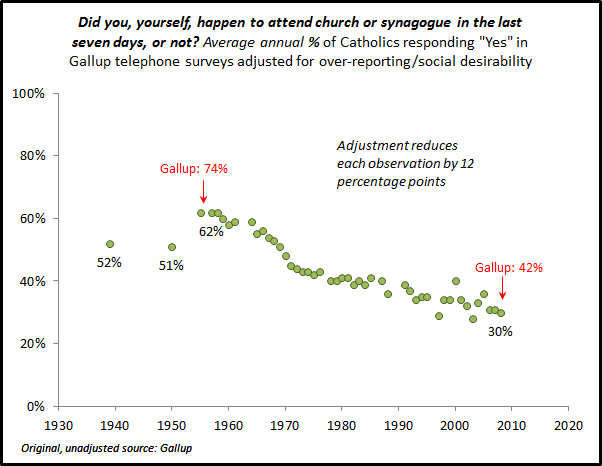The following statistics are (or should be) sobering for the Church as a whole in this country because they are not unique to the Pittsburgh Diocese:
The number of active Catholics within the Pittsburgh Diocese has declined rapidly in recent decades, from 914,000 in 1980 to 632,000 in 2015, diocesan figures show.
Since 2000, weekly Mass attendance has dropped by 40 percent – for almost 100,000 fewer regular churchgoers; K-8 Catholic school enrollment fell by 50 percent; and the number of active priests plummeted from 338 to 225. By 2025, if trends hold, the diocese projects that just 112 active priests will remain.
By any honest evaluation, these numbers spell very serious problems, and the bishop of Pittsburgh expressed his deep concern in an interview with a large secular newspaper in that city. The whole U. S. Conference of Catholic Bishops should be deeply concerned because these kinds of statistics can be found in most dioceses and archdioceses in this country with a few exceptions.
But the solutions that the good bishop is proposing in order to reverse this decline are not particularly encouraging, and remind me of the futile five-year plans of the Soviet Union, which kept repeating the same failed remedies: “The No. 1 priority has to be, ‘We need to make our worship better,’” [Bishop David] Zubik told the Tribune-Review. “Second of all, we need to do the best job that we can to get not only more ordained leaders, but we really have to open up lots of doors for the lay leaders of the Church.”
According to the paper, “better worship” means “better homilies, better music,” and “getting churches to be more hospitable to outsiders.” The bishop adds other possible remedies, such as “growing the pools of highly trained lay leaders and deacons. . .appealing to youths through new types of ministry while simultaneously strengthening pastoral care for the elderly.”
Haven’t we heard all this before: more lay leaders and permanent deacons with better training, better youth programs, better pastoral care of the elderly? My cynicism makes me think that the last proposal is a way to help solve the financial problems partly caused by parishes and chanceries being hugely overstaffed, with lay salaries and benefits.

But all that aside, we’re regularly told that the causes of declining numbers of practicing Catholics across these fruited plains are mainly structural and programmatic. Better programs, better worship, better welcoming is all we need to reverse this devastation that no one would have predicted following Vatican II. Maybe it’s time to consider other possibilities.
The real underlying problem is simple: it’s a massive loss of faith. There are many reasons for that loss of faith. But Catholics are dropping out in droves because they have lost their faith, or never really had faith, in the Church or in the true nature of her sacraments. It’s not because homilies are poor. Homilies were very often poor in the old days, too, when the churches were full. It’s not because the music is not up to snuff. In the 1940s and 1950s, we had no music except at the solemn high Mass on Sundays and holy days. Yet the churches were full. The problem is simply a tremendous loss of faith.
About thirty years ago, a reliable survey revealed that only around 30 percent of Catholics believed in the real presence of Christ in the Eucharist any longer. Why didn’t the bishops call an emergency meeting to reflect on this loss of faith, as they did in 2002 to deal with sexual abuse. If people don’t believe in the Real Presence of Christ in the Eucharist or in the Eucharist as a true sacrifice being offered to God on behalf of sinners, better music is not going to attract them to Mass on Sunday mornings.
The loss of faith reflects a loss of the sense of sin and sin’s gravity. Both are surely related to the rejection of the Church’s moral teachings, for faith is indeed a seamless garment. So the Sunday obligation means nothing and is not going to keep people coming to church who do not believe in the gravity of the sin of missing Mass. Indeed, even if you believe there is such a thing as grave sin, how could that sin be seen as grave if you believe that the Mass is essentially music and readings and a bit of memorial. Not something real, a real sacrifice, a real presence of Christ.
Even partisans of the Extraordinary Form, who also think that if we just restore the liturgy faith will be restored, should understand that it’s not that simple. Many things have gone into this crisis and need attention; long-standing poor catechesis, poor example, scandal, and yes bad liturgy, to be sure. But also: the lack of proclamation of the Gospel in the public square. Since people aren’t in the churches, the Gospel has to be preached to them where they are. If the church is just another “denomination” in the public square, and the Gospel is not being openly proclaimed as the solution to societal problems, then we are indeed in for a long ecclesial winter.
Bishop Zubik did actually mention the problem of faith when he said “at the same time, I found they [parishioners] were very excited about the important aspect of why we’re doing this: to enliven people’s faith.”
Bishop, the truth is that one first has to have faith in order to have it enlivened. The highest priority, then, has to be this basic question: what has caused this massive loss of faith, and how do we work to resurrect that lost faith?















